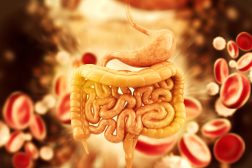Table of Contents
Definition
noun
plural: fatty acids”
fatty acid, ˈfætɪ ˈæsɪd
Any of the group of a long chain of hydrocarbon with a carboxylic acid at the beginning and a methyl end, and derived from the breakdown of fats (through hydrolysis)
Details
Overview
A fatty acid is a subunit of fats, oils, and waxes. It pertains to any long chain of hydrocarbon, with a single carboxylic group and aliphatic tail. It is produced by the breakdown of fats (usually triglycerides or phospholipids) through a process called hydrolysis. Fatty acids are a subgroup of lipids. Other major types of lipids are glycerol, glycerophospholipid, sphingolipid, sterol lipid, and prenol lipid. Lipids are organic compounds that are readily soluble in nonpolar solvent (e.g. ether) but not in polar solvent (e.g. water).
Structure
A fatty acid may be represented by R-COOH, where R stands for the aliphatic moiety and COOH as the carboxylic group (making the molecule an acid). The general formula is CnH2n+1COOH. Almost all natural fatty acids have an even number of carbons. This is because fatty acids are synthesized by adding two carbons each time to malonyl-CoA.
Types
Fatty acids can be classified into two major groups depending on the nature of covalent bond: (1) unsaturated fatty acid and (2) saturated fatty acid. Unsaturated fatty acids those containing one or more double bonds and therefore can absorb additional hydrogen atoms. They may be further categorized into monounsaturated and polyunsaturated fats. Examples of unsaturated fats are monounsaturated fatty acid, polyunsaturated fat, omega fatty acids, etc. Saturated fatty acids are fatty acids that lack unsaturated linkages between carbon atoms. Examples include lauric acid, palmitic acid, etc.
Another way of classifying fatty acids is based on the length of the chain. A fatty acid with aliphatic tail of five or fewer carbons is called a short-chain fatty acid. Medium-chain fatty acid is one that has an aliphatic tail of 6 to 12 carbons. A long-chain fatty acid is one that has an aliphatic tail of 13 to 21 carbons. A fatty acid with an aliphatic tail of 22 or more carbons is called very long chain fatty acid.
Essential fatty acids are a special type of fatty acids. They are called as such because we derive them from diet as we cannot produce them on our own. Examples of essential fatty acids are linoleic acid and alpha-linolenic acid (ALA), which are present in plant oils.
Common biological reactions
Common biological reactions
In the cell, fatty acids are synthesized in the cytosol. In animals, fatty acid biosynthesis occurs in liver and adipose tissue. It also occurs in the mammary glands during lactation. The process begins in the conversion of carbohydrate into pyruvate (via glycolysis) in the cytosol. Pyruvate enters the mitochondrion to be converted into acetyl CoA. The acetyl CoA is activated to enter the citric acid cycle where it is converted into citrate by reacting with oxaloacetate, which displaces the coenzyme A. In synthesizing fatty acid, citrate leaves the citric acid cycle and the mitochondrion. Once in the cytosol, it is cleaved into acetyl-CoA and oxaloacetate by the enzyme ATP citrate lyase. (Oxaloacetate returns to the mitochondrion for the citric acid cycle) The acetyl CoA in the cytosol is converted into malonyl-CoA by carboxylation through the enzyme acteyl CoA carboxylase. This step is considered as the committed step in fatty acid biosynthesis. The fatty acid chain grows by two carbons at a time. Fatty acid synthesis almost always culminates in the addition of three fatty acids to one glycerol molecule, producing triglyceride” (fat). Triglycerides may be broken down by lipolysis to liberate fatty acids (called “free fatty acids”). The fatty acids in the bloodstream are shuttled by available plasma albumin. They are taken up by cells to be metabolized in the citric acid cycle inside the mitochondrion.
Common biological reactions
Fatty acids are degraded when they are taken up by cells for beta-oxidation and then for combustion via citric acid cycle. The process leads to the formation of CO2 and water.
Functions
Fatty acids are an important constituent of triglycerides (fats). Triglycerides are one of the biomolecules that store chemical energy that can fuel metabolic processes such as muscular contraction. They are also a vital structural component of the biological membranes of cells and organelles.
Supplementary
Derived term(s)
- Volatile fatty acid number
- Unesterified free fatty acid
- Saturated fatty acid
- Fatty acid methyltransferase
- Fatty acid oxidation cycle
- Fatty acid reductase
Further reading
See also
Mention(s)
© Biology Online. Content provided and moderated by Biology Online Editors







